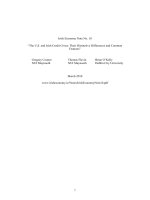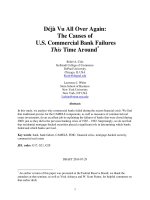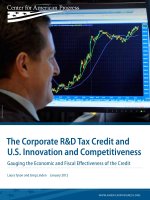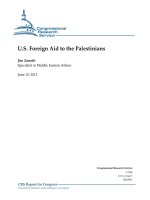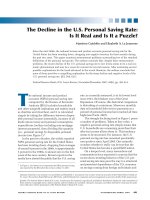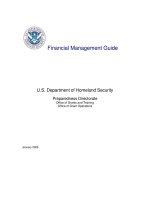wolfson - financial crises; understanding the postwar u.s. experience (1986)
Bạn đang xem bản rút gọn của tài liệu. Xem và tải ngay bản đầy đủ của tài liệu tại đây (15.63 MB, 244 trang )
UNDERSTANDING
THE
POSTWAR
U.S.
EXPERIENCE
By
Martin
H.
Wolf-son
t:5V1E
SharpelNC
ARMONK, NEW YORK
LONDON,
ENGLAND
Copyright © 1986 by Martin H. Wolfson
All rights reserved.
Available in the
United Kingdom and Europe from M. E. Sharpe,
Publishers, 3 Henrietta Street, London WC2E 8LU.
Library
of
Congress Cataioging in Publication Data
Wolfson, Martin H.
Financial crises.
Bibliography: p.
',I. Depressions.
:2.
Business cycles.
3;'
Business
cycles-United
States.
I.
Title. . 1
'-
;
ISBN 0-87332-376-9 '
ISBN 0-87332-377-7 (pbk.)
Printed in the
United States
of
America
To
my
parents
Eli and Emma Wolfson
of
Figures
List
of
Tables
Acknowledgments
1. Introduction
PART I. THEORIES
OF
FINANCIAL CRISES
2. Theories
of
Financial Crises
3. Comparison
of
Theories
of
Financial Crises
Contents
ix
x
xi
3
13
34
PART
11.
FINANCIAL CRISES IN
THE
POSTWAR U.S. ECONOMY
4. The Credit Crunch
of
1966
5. 1970:
Penn Central
6. 1974: Franklin National
7. The Silver Crisis
of
1980
8. The 1982 Crisis
9. The Legacy
of
1982
PART
Ill.
UNDERSTANDING
THE
POSTWAR EXPERIENCE
10. A Business-Cycle Model
of
Financial Crises
11. Evaluating the Business-Cycle Model
12. Evaluating the Theories
of
Financial Crises
13. Changes in Financial Crises: The Role
of
Long-Term Trends and Institutional Change
Notes
Selected Bibliography
Index
43
52
61
72
89
106
125
132
170
188
201
214
219
of
Figures
11.1 Debt-Equity Ratio
11.2 Debt Maturity Ratio
11.3 Liquidity Ratio
11.4 Interest Coverage Ratio
11.5 Bank Prime and Commercial Paper Rates
11.6 Corporate
Bond
Interest Rates
11.7 Profit Rate
11.8 Financing Gap
11.9 Investment Contracts and Orders
11.10
Plant and Equipment Investment
11.11
Stock Market Price Index
11.12 Inventory Investment
11.13 Inventory-Sales Ratio
11.14 Capital Expenditures and Internal Funds
11.15 Internal Funds and Components
11.16 Nonfinancial Corporate Debt
11.17 Nonfinancial Corporate Bank Loans
11.18 Bank Loan Losses
11.19 Business Loan Demand
11.20 Bank Lending Practices
11.21 Loan Commitments
11.22 Bank Purchased Funds
12.1 Monthly Growth Rate
of
Ml
13.1 Debt-Equity Ratio
13.2 Debt Maturity and Liquidity Ratios
13.3 Bank Asset Liquidity Ratio
13.4 Exchange
Value
of
U.S. Dollar
134
135
136
137
140
141
142
143
145
146
147
148
149
150
151
152
153
154
156
158
160
161
184
193
194
195
197
List
of
Tables
11.1
Dates
of
Financial Crises
133
11.2 'furning Points
of
Financial Ratios
138
11.3 'furning Points
of
Determinants
of
the Interest Coverage Ratio
139
11.4 'furning Points
of
Profit and Investment Variables
144
11.5 Net Charge-Offs
of
Commercial and Industrial Loans
155
11.6 Changes
in
Components
of
Bank Credit
Prior
to
Financial Crises
162
12.1 Selected Monthly Growth Rates
of
M 1 and Bank Investments
185
Acknowledgments
There are a number
of
people who have helped me in the writing
of
this
book. Both Ray Boddy and Bob Pollin read an earlier draft
of
the entire manu-
script and made numerous useful suggestions.
Others who helped in various ways
include Bill Charwat, Jacob Cohen, Jim Crotty, Andre Gunder Frank, Ellen
Hancock,
Sue Headlee, Jeff Keefe, David Kotz, Perry Mehrling, Chris Niggle,
Kevin Quinn, Lou Schorsch, Bud Talley, John Willoughby, and Ken Woodward.
Of
course the responsibility for any errors rests solely with the author.
This book grew out
of
my Ph.D. dissertation on the same topic, and I would
also like to thank the members
of
my dissertation
committee-Ray
Boddy, Cyn-
thia Morris, and Robin
Hahnel-for
their help. Cynthia Morriss's understanding
of
methodology, organization, and historical perspective was quite helpful, as
was Robin Hahnel's insightful analysis. I am especially grateful to Ray Boddy.
His theoretical understanding and democratic style were important attributes in
his capacity as chairman
of
the committee, and he has provided much help and
advice throughout the long gestation period
of
this book.
I am indebted to my colleagues at the Federal Reserve Board, who have
taught me much about banking and the financial system. In particular I would like
to thank Bill Charwat, Tony Cornyn, Ellen Hancock, Jim Houpt, Mike Martin-
son, and Bud Talley. It should be stressed, however, that the opinions expressed in
this book are those
of
the author. They do not necessarily reflect the views
of
the
Board
of
Governors
or of
any other staff member
of
the Federal Reserve System.
A special word
of
thanks goes to Ginger Pittman, who typed the manuscript
with speed, accuracy, and enthusiasm. I would also like to note the efforts
of
Dick
Bartel, my editor at M. E.
Sharpe, Inc. who took over the supervision
of
this
book during a difficult time and has seen it through many twists and turns
to
publication. In addition, Alfred Eichner, as a reviewer for M. E. Sharpe, Inc.,
made several helpful comments on the manuscript. Last, but not least, I would
like to thank my wife, Linda, for her help, advice, and
support-all
of
which
made it possible for me to complete this book.
Over the course
of
my
studies in economics I have had a number
of
exceptional teachers, in particular Joseph Conard, Frank Pierson, Ray Boddy,
Cynthia Morris, and Chuck Wilber. They have paid attention not only to the
xii ACKNOWLEDGMENTS
development
of
ideas, but also to the communication
of
those ideas to their
students. Even more importantly, they have helped me realize that an understand-
ing
of
how the economy works is an important first step in changing that economy
to benefit the majority
of
the people. My goal in this book has been to contribute
to an understanding
of
an important aspect
of
the economy's functioning,
i.e.,
how and why financial crises occur.
If
the reader's understanding has increased as
a result
of
reading this book, that goal will have been achieved.
FINANCJATJ
CWiIiS
UNDERSTANDING
THE
POSTWAR
U.S.
EXPERIENCE
In the nineteenth and early twentieth centuries, financial crises occurred regularly
in the
United States, with particularly severe episodes in 1873 and 1893. Closer to
the present time were the
Panic
of
1907 and the banking crises that took place
during the Great Depression
ofthe
1930s. In that latter case, faith in the banking
system had fallen to such a low level that a national Banking Holiday was
declared
on
March
6,
1933, and all banks in the United States were closed for a
period
of
time.
The severe financial and economic trauma
of
the Great Depression led to
major reforms in the structure
of
the economy, including important institutional
changes in banking and finance. The hope at the time was that these reforms
would put an end to the dislocations resulting from financial crises.
For a while after the Great Depression and the
Second World War, it
appeared that these hopes might be realized. For twenty years after the end
of
World War
11,
although certain sectors
of
the economy suffered financial strains
from time to time, events in the financial markets did not resemble those that took
place during the financial crises
of
an earlier era.
During the period immediately following World War
11,
when financial
crises seemed to have disappeared forever from the economic scene, mention
of
them also disappeared from the economics literature. Nearly an entire generation
of
economists was trained without ever studying the origins and causes
of
finan-
cial crises.
If
the prevailing wisdom were true, though, such neglect made sense:
why study a phenomenon that no longer existed?
Thus the
"credit
crunch"
of
1966 came as quite a shock. For a period
of
time during the summer
of
1966, the market for municipal securities was
"disor-
ganized" by the liquidation
of
bonds from commercial bank portfolios, and thrift
institutions came under strong financial pressure. Events seemed to be develop-
ing in the same way as they had during past financial crises.
As it turned out, the crisis was resolved before it caused significant damage
to the economy. Though the 1966 crisis was much less intense than the
Panic
of
1907
or
other similar crises, it was nonetheless a shock to observers who had
thought financial crises were a thing
of
the past.
The credit crunch
of
1966 was followed by another crisis in 1970. Then the
surprise bankruptcy
of
the Penn Central company threatened the commercial
paper market and led to a
"flight
to
quality"
(Le., a preference for safe invest-
ments). Corporations that had relied upon commercial paper borrowing scram-
bled desperately for alternative sources
of
funds. As in 1966, prompt action by
the Federal Reserve Board in its capacity as lender
of
last resort, and appropriate
4 FINANCIAL CRISES
monetary and fiscal policies, prevented the crisis from developing into a full-scale
panic. The downturn in economic activity was relatively mild, but
of
greater
intensity than the growth recession
of
1966.
In 1974 an even more serious financial crisis took place when the troubles
of
the Franklin National Bank, the twentieth-largest bank in the United States,
were announced
in
May.
This time the crisis had international implications.
Franklin had borrowed heavily in the Eurodollar interbank market and had
engaged in substantial foreign-exchange speculation. Both
of
these markets were
threatened by Franklin's difficulties. In addition, the market for bank certificates
of
deposit in the United States came under increased pressure.
Again, government action prevented the situation from escalating rapidly.
At the time, however, it became quite clear that the economy
of
the United States
was susceptible to financial crises.
Silver speculation by the billionaire Hunt brothers again threatened to set
off
a serious financial crisis in 1980. When the price
of
silver began to fall in
January
1980, the Hunts borrowed on a massive
scale-an
incredible total
of
nearly
$1
billion-from
commercial banks in order to cover their losses. Poten-
tial default on this mountain
of
debt put the banking system under considerable
pressure.
A financial crisis occurred again in 1982. Because
of
the degree
of
intercon-
nection among the nation's banks, the failure
of
two relatively small financial
institutions-Drysdale Government Securities, Incorporated, and
Penn Square
National
Bank-affected
other, bigger institutions and created a crisis
of
confi-
dence in the banking system as a whole.
In addition, conditions in 1982 pushed two other problems toward crisis
proportions: the financial troubles
of
savings and loan associations and the debt
burden ofless-developed countries. In September 1982, fear
of
Mexico's default
on its obligations to commercial banks aggravated the banks' problems, set
off
a
capital flight, and required lender-of-last-resort operations on an international
scale to manage the crisis.
The problems
of
financial intermediaries continued past 1982. Weakened
significantly
by
the legacy
of
bad loans they had purchased from Penn Square,
both Continential Illinois and Seattle First National Banks were hit by a run on
deposits by large investors.
Only an unprecedented government bailout in the
summer
of
1984 prevented the difficulties at Continental from spreading
throughout the banking and financial systems.
The thrift industry also continued to be under financial pressure. During the
summer
of
1984, a run developed on the deposits
of
the American Savings and
Loan Association, the largest thrift in the
United States and a subsidiary
of
the
Financial Corporation
of
America. In March 1985, the failure
of
ESM Govern-
ment Securities, Inc., a small securities dealer in Florida, resulted
in
the closing
of
Home State Bank in Ohio. Home State's deposits were insured by a state-
backed fund, rather than the federal government. The demise
of
Home State
INTRODUCTION 5
threatened the solvency
of
the fund, led to a run on the deposits
of
all seventy-one
state-insured thrifts in
Ohio, and eventually led
to
their closing by the governor
of
Ohio. A similar crisis developed among state-insured thrifts in Maryland. The
image
of
depositors waiting in long lines to withdraw their money was one that
had not been seen in the
United States since the Depression.
Despite the reemergence
of
the phenomena
of
financial crises in the
postwar period, and despite the threat they pose to the financial system, our
theoretical understanding
of
the causes
of
financial crises has not proceeded
apace. As Allen
Sinai has noted: "Despite repeated trauma from financial distur-
bances, systematic study
of
the financial environment, in the same sense that
other topics have been formally analyzed
by
economists, has been sparse.
"1
In contrast, in the earlier period, when financial crises were associated with
severe dislocations
of
the financial system and deep depressions, economists
studied them intently. Theories
of
financial crises were quite widespread.
One writer who maintained this earlier interest in financial crises was
Hyman
P.
Minsky, a financial economist and monetary theorist. Even before the
first financial crisis
of
the postwar period, the credit crunch
of
1966, Minsky was
developing models
of
financial crises and predicting that disturbances
of
this sort
could reappear.
2
Now that financial crises have in fact reappeared, other economists have
begun to follow Minsky's lead. For example, Charles
P.
Kindleberger has recent-
ly
published a book entitled Manias, Panics, and Crashes. 3 In it he uses a
framework similiar to Minsky's to investigate international speculative distur-
bances dating back to the early eighteenth century. Interest in the topic
of
financial
crises has gradually increased, although it still remains, as
Sinai said, relatively
sparse.
4
Moreover, much
of
the work on financial crises that has taken place recently
has proceeded without specific reference to the in sights
of
the theorists who wrote
during the time when financial crises were more severe. This book hopes to
remedy that defect to some extent by investigating the ideas
of
those earlier
theorists.
Thus Chapter 2 discusses in detail the writings
of
a variety
of
theorists who
have made contributions to the topic
of
financial crises. It examines not only
theorists from both the earlier and modern eras; it also attempts to investigate
theorists from a variety
of
perspectives. These include Thorstein Veblen, Wesley
Clair Mitchell, Karl Marx, Hyman
P.
Minsky, AlIen Sinai, Albert M. Wojni-
lower, and Milton Friedman.
S
Despite the widely different theoretical and ideological traditions to which
these writers belong, there are certain common approaches among at least a
majority
of
the writers. These approaches taken together do not constitute a
theory, but do indicate a certain perspective on how to approach the task
of
empirically testing the various theories. In addition, they provide a convenient
framework that can be used to focus on the particular differences among the
6 FINANCIAL CRISES
theorists, and to highlight specific theoretical questions to be investigated.
Without such a basic perspective it would be difficult to know how to
approach the data. As Schumpeter has said,
"Raw
facts are, as such, a meaning-
less jumble.
"6
One needs to know how to organize the data, what questions to
ask, and on what variables to focus. This perspective, it is contended, is basically
compatible with the theories
of
six
of
the seven writers mentioned above (Milton
Friedman's theory is the exception).
It
consists
of
two major points.
First, financial crises are the result
of
the normal functioning
of
the eco-
nomic and financial systems over the course
of
the business cycle. Endogenous
processes take place near the peak
of
the expansion phase
of
the business cycle, in
particular, the deterioriation
of
the financial condition
of
the business sector,
which set the stage for a financial crisis. This point may be termed the general
business-cycle perspective.
Second, the crisis is brought about because
of
developments in the demand
and supply
of
credit. The key to understanding why the crisis occurs is to be found
in the way the supply
of
credit falls short
of
the demand. Especially important
here is the role
of
the commercial banks. The crisis itself is a response to these
developments which involves a disruption to the financial system. This point is
referred to as the credit-market perspective.
With this general orientation, it is possible to approach the data in a
coherent
way.
Our interest is focused on developments in the corporate and
banking sectors near the peak
of
the expansion phase
of
the business cycle.
We
can look to see
if
the financial condition
of
the business sector deteriorates, and
how this development affects the banks and the demand and supply
of
credit.
Finally, we can investigate how these events affect the functioning
of
the financial
system.
However, Milton Friedman rejects the general business-cycle, credit-mar-
ket perspective, and thus his theory will not be directly evaluated using that
approach. Friedman does not place his theory
of
financial crises within the
context
of
the business cycle, and his focus is on movements in the money supply
rather than on developments in the credit markets. His views will be evaluated
separately,
by
focusing specifically on the relationships that he identifies.
For the other six writers, though, as mentioned above, the business-cycle,
credit-market perspective provides a convenient way to approach the data. It also
serves as a context within which to understand the significant differences among
these writers, and therefore focuses attention on the most important theoretical
issues (differences) to investigate empirically. These issues have to do with
(1) the reasons for the development
of
financial difficulties in the business sector,
(2) the factors influencing the demand and supply
of
credit, and (3) the defining
patterns
of
a financial crisis.
Let us consider first the reasons for the development
of
financial difficulties
in the business sector. Are these difficulties due only to an increase in interest
rates and a consequent escalation
of
debt payment requirements (Minsky),
or
are
INTRODUCTION 7
they due also to a decline in profits (Marx, Veblen, Mitchell)?
How do these developments affect the demand and supply
of
credit? With
regard to the demand for credit, do these financial difficulties mean that business
has a
"necessitous" demand due to an inability to meet fixed payment commit-
ments (Minsky, Marx, Mitchell),
or
is the significance
ofthe
financial difficulties
primarily that firms have an increased demand for funds to expand
"voluntary"
investments and increases in production (Sinai, Wojnilower)?
If
necessitous, is
the demand for credit due to a need to meet debt payment requirements (Minsky,
Marx), is it to pay for investment projects initiated at an earlier time (Minsky,
Mitchell),
or
is
it
for both?
With regard to the supply
of
credit, the main issue concerns the source
of
the limitation. All the writers recognize a limitation on the supply
of
credit due to
a conscious tightening
of
monetary policy by the Federal Reserve Board (for the
modern
period),
or
adjustments required by the gold standard (in the earlier
period). The key question concerns the reaction
of
the banks. Do they voluntarily
limit credit because
of
the decreased creditworthiness
of
their business borrowers
(Veblen, Mitchell, Minsky)
or
do they try to accommodate the increased business
loan demand (Wojnilower)?
If
they try to accommodate the demand for credit,
what
is
the source
of
the interruption in the supply
of
credit?
The final set
of
questions concerns the nature and definition
of
the financial
crisis itself. What is a financial crisis? Is it a gradual liquidation
of
credit
(Veblen),
or
does it involve a more intense reaction, an urgent demand for money
(Marx, Wojnilower)? Does a psychological
"panic" reaction play an important
role (Mitchell, Marx, Minsky, Wojnilower),
or
is this reaction less significant
(Veblen,
Sinai)?
Also, are there regularities in the form the crisis takes? Does it involve the
forced sale
of
assets (Minsky), an intensified effort to borrow (Marx, Mitchell),
bank runs (Mitchell), a disruption
of
financial markets (Wojnilower)?
These theoretical issues are discussed in more detail and compared in
Chapter
3,
which draws upon the examination
of
the views
of
the individual
theorists in Chapter 2. The remainder
of
the study then sets about to resolve these
issues and to develop a coherent theoretical understanding
of
the financial crises
that have occurred in the postwar period in the United
States.
Part
11
(Chapters 4-9) is an in-depth examination
of
these financial crises,
including the events in the economy leading up to the crises. The approach to the
data is guided by the theoretical business-cycle, credit-market perspective dis-
cussed above.
The method employed, dictated by the nature
of
the subject matter to be
investigated, is institutional, dynamic, and historical. It is institutional because
the particular institutions
of
the postwar economy-particularly institutional
constraints on bank
lending-have
played an important role in affecting how
financial crises have unfolded and developed.
It
is dynamic because the events
of
financial crises, involving uncertainty, psychological reactions, and disruptions
8 FINANCIAL CRISES
to financial markets, cannot be modeled in a static framework. Finally, it is
historical because financial crises are due to an evolution
of
events constantly
unfolding in historical time; the concept
of
financial crises and business cycles
underlying the theoretical perspective discussed above is that
of
a process
of
endogenous change and perpetual diseqUilibrium. In the words
ofJoan
Robinson:
Once we admit that an economy exists in time, that history
goes one way, from the irrevocable past into the unknown fu-
ture, the concept
of
equilibrium based on the mechanical
analogy
of
a pendulum swinging to and fro
in
space becomes
untenable. The whole
of
traditional economics needs to be
thought out afresh.
7
The econometric approach, while useful for many applications, has prob-
lems in capturing the nature
of
the process being investigated here. The need to
consider historical, dynamic, and disequilibrium phenomena makes econometric
modeling difficult. The investigation in
Part
11
is quantitative, however, in the
sense that time series data are utilized in connection with the investigation
of
financial crises. The primary questions to be answered by these data, though, are
those concerning timing and the direction and magnitude
of
change in variables,
rather than those involving more formal statistical conclusions.
Chapter 10
of
Part III draws out the implications
of
the investigation
of
Part
IT
and presents the results in a business-cycle model
of
financial crises: a model
of
how endogenous changes near the peak
of
the expansion phase
of
the business
cycle create the conditions that make financial crises likely. The model is devel-
oped by addressing the theoretical issues discussed above.
Some comments about the nature
of
the model are perhaps in order. It is not
a formal, deductive model whose conclusions follow logically from its assump-
tions; rather, the structure
of
the model is determined by the natUre
of
the
empirical events surveyed in
Part
11.
The model is formulated by linking together
conclusions about the theoretical issues into an overall conception
of
how finan-
cial crises develop. The purpose
of
the model is to aid understanding, rather than
necessarily to enable prediction.
However, the model is not a mere statement
of
an observed sequence
of
events. It is a theory in the sense that it includes causal statements and proposi-
tions about the behavioral motivations
of
essential economic actors. Nonetheless,
it is a carefully limited theory. It is a theory
of
financial crises, not
of
business
cycles. It does not attempt to address financial developments over the business
cycle as a whole, but focuses instead only on developments near the peak
of
the
expansion. Moreover, it does not attempt to explain the behavioral motivations
for certain important developments, such as the reason for the decline in profits
toward the end
of
the expansion. It simply observes that profits do fall. Important
and complicated questions involved in the theory
of
investment are only briefly
mentioned.
INTRODUCTION 9
Despite its emphasis on understanding rather than prediction, the model is
capable
of
being evaluated, according to how accurately and consistently it gener-
alizes the postwar history
of
financial crises. This evaluation is carried out in
Chapter 11.
Chapter
12
compares the postwar experience to the theories
of
financial.
crises considered in Part
I.
Chapter
13
takes a broader look at the history
of
financial crises.
It
indicates the need to integrate long-term trends and institution-
al change with the cyclical forces discussed in Chapter 10, in order to obtain a
more complete understanding
of
how financial crises change over time.
It
com-
pares the recent period with the past, and also considers how financial crises
might currently be
in
the process
of
change.
of
Financial
Crises
of
Financial
Crises
The purpose
of
this chapter
is
to set out the main theories and concepts that have
been developed to explain the phenomenon
of
financial crises. No attempt has
been made to be exhaustive; rather, the emphasis is on the major theoretical
viewpoints
of
writers from a variety
of
different perspectives within economics.
Theorists
of
the late nineteenth and early twentieth centuries have been
included, as mentioned in the Introduction. The assumption
is
that at least some
basic processes involved
in
financial crises are due to the fundamental workings
of
an industrialized capitalist economy. More contemporary theorists,
of
course,
are also discussed.
Earlier Theorists
Thorstein
Veblen
An analysis
of
financial crises was developed in 1904 by Thorstein Veblen, the
founder
of
the institutionalist approach within economics. His theory
of
financial
crises
is
based upon the effects
of
movements in the rate
of
profit upon the
extension
of
credit. 1
Veblen stresses the central role
of
profits. For him, profit considerations
dominate business decisions, and the degree to which profits are realized can
affect the overall economy:
"Times are good or bad according as the process
of
business yields an adequate or inadequate rate
of
profits." He distinguishes
between two types
of
credit: (1) "deferred payments in the purchase and sale
of
goods" (what today
we
would call trade credit) and (2) "loans
or
debt-notes,
stock shares, interest-bearing securities, deposits, call loans,
etc."
2 His view
is
that credit
is
necessarily employed in business expansions, and that its use
inevitably spreads throughout the economy:
Whenever the capable business manager sees an appreciable
difference between the cost
of
a given credit extension and
the gross increase
of
gains to be got by its use, he will seek

